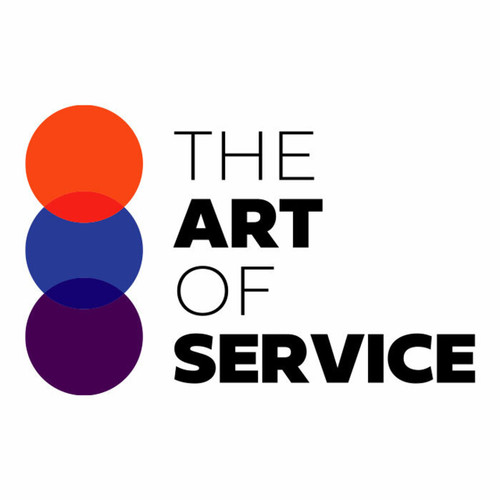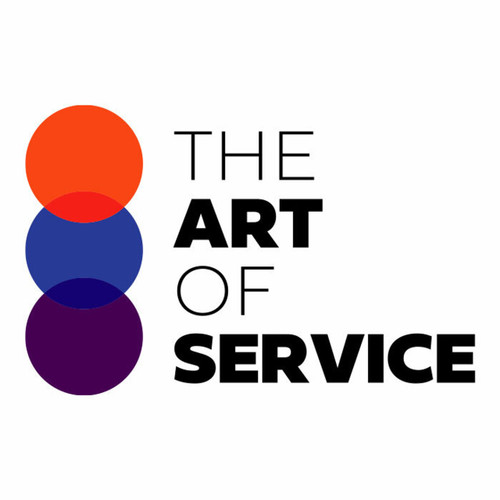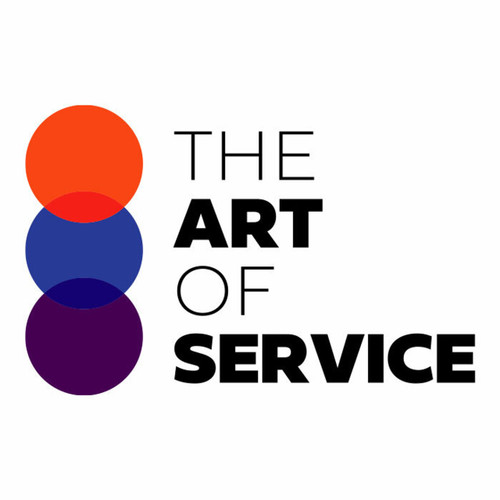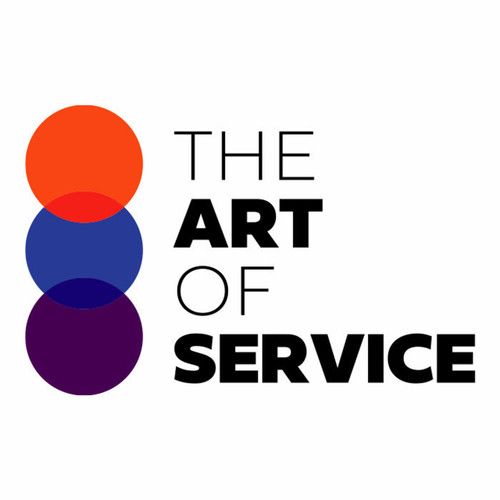With our dataset of 1501 prioritized FMEA requirements, solutions, benefits, and results, coupled with example case studies and use cases, you′ll have all the information you need to effectively identify, assess and mitigate potential failures.
Our FMEA and Knowledge Base cover the most important questions to ask in terms of urgency and scope, ensuring that you have a holistic understanding of your risk landscape.
But what sets our FMEA and Knowledge Base apart from competitors and alternatives? Our product is designed specifically for professionals like you, making it a must-have tool for any industry or business dealing with potential failures.
It′s easy to use and doesn′t require any specialized knowledge, making it the perfect choice for DIY and affordable failure prevention.
We pride ourselves on providing a detailed overview of failure modes and effects, allowing you to prioritize and mitigate risks based on your specific product type.
The benefits of using our FMEA and Knowledge Base are endless - from saving time and resources to preventing costly failures and maintaining customer satisfaction.
Our research on FMEA and Knowledge Base has shown that it is an essential tool for businesses of all sizes.
Even better, it is incredibly cost-effective compared to other solutions on the market.
Don′t take our word for it, try it out for yourself and experience the pros of having a comprehensive FMEA and Knowledge Base at your fingertips.
In a nutshell, our FMEA and Knowledge Base is a one-of-a-kind tool that helps you stay ahead of potential failures and their consequences.
Say goodbye to manual and time-consuming failure management and hello to a more efficient and effective approach.
Don′t wait any longer, get our FMEA and Knowledge Base today and ensure the success and reliability of your products and services.
Discover Insights, Make Informed Decisions, and Stay Ahead of the Curve:
Key Features:
Comprehensive set of 1501 prioritized Failure Mode and Effects Analysis requirements. - Extensive coverage of 100 Failure Mode and Effects Analysis topic scopes.
- In-depth analysis of 100 Failure Mode and Effects Analysis step-by-step solutions, benefits, BHAGs.
- Detailed examination of 100 Failure Mode and Effects Analysis case studies and use cases.
- Digital download upon purchase.
- Enjoy lifetime document updates included with your purchase.
- Benefit from a fully editable and customizable Excel format.
- Trusted and utilized by over 10,000 organizations.
- Covering: Reliability Targets, Design for Manufacturability, Board Best Practices, Effective Presentations, Bias Identification, Power Outages, Product Quality, Innovation, Distance Working, Mistake Proofing, IATF 16949, Strategic Systems, Cause And Effect Analysis, Defect Prevention, Control System Engineering, Casing Design, Probability Of Failure, Preventive Actions, Quality Inspection, Supplier Quality, FMEA Analysis, ISO 13849, Design FMEA, Autonomous Maintenance, SWOT Analysis, Failure Mode and Effects Analysis, Performance Test Results, Defect Elimination, Software Applications, Cloud Computing, Action Plan, Product Implementation, Process Failure Modes, Introduce Template Method, Failure Mode Analysis, Safety Regulations, Launch Readiness, Inclusive Culture, Project communication, Product Demand, Probability Reaching, Product Expertise, IEC 61508, Process Control, Improved Speed, Total Productive Maintenance, Reliability Prediction, Failure Rate, HACCP, Failure Modes Effects, Failure Mode Analysis FMEA, Implement Corrective, Risk Assessment, Lean Management, Six Sigma, Continuous improvement Introduction, Design Failure Modes, Baldrige Award, Key Responsibilities, Risk Awareness, DFM Training, Supplier Failures, Failure Modes And Effects Analysis, Design for Serviceability, Machine Modifications, Fault Tree Analysis, Failure Occurring, Hardware Interfacing, ISO 9001, Common Cause Failures, FMEA Tools, Failure modes, DFM Process, Affinity Diagram, Key Projects, System FMEA, Pareto Chart, Risk Response, Criticality Analysis, Process Controls, Pressure Sensors, Work Instructions, Risk Reduction, Flowchart Software, Six Sigma Techniques, Process Changes, Fail Safe Design, DFM Integration, IT Systems, Common Mode Failure, Process FMEA, Customer Demand, BABOK, Manufacturing FMEA, Renewable Energy Credits, Activity Network Diagram, DFM Techniques, FMEA Implementation, Security Techniques, Top Management, Failure Acceptance, Critical Decision Analysis
Failure Mode and Effects Analysis Assessment Dataset - Utilization, Solutions, Advantages, BHAG (Big Hairy Audacious Goal):
Failure Modes
The corrective action would be incorporated into the FMEA as a precaution against the failure mode, to prevent or minimize its occurrence.
1. Implementing stricter quality control measures to prevent failure modes from occurring. Benefit: Ensures that potential failures are caught before they occur, reducing the need for corrective action.
2. Adding redundancy or backup systems to minimize the impact of potential failures. Benefit: Provides a safety net in case one component fails, preventing cascading failures and reducing downtime.
3. Updating maintenance and inspection procedures to catch potential failures earlier. Benefit: Allows for proactive identification and prevention of failure modes, reducing the likelihood of costly repairs or replacements.
4. Improving product design to make it more robust and less susceptible to failure modes. Benefit: Reduces the likelihood of failures occurring, increasing customer satisfaction and decreasing costs associated with failures.
5. Improving communication and collaboration among team members to ensure all potential failure modes are identified and addressed. Benefit: Increases accountability and improves the overall effectiveness of the FMEA process.
6. Conducting regular FMEA reviews to identify new failure modes or changes that may affect the previous analysis. Benefit: Keeps the FMEA up to date and relevant, ensuring that all potential risks are continuously evaluated and mitigated.
7. Utilizing advanced technology such as predictive maintenance to detect potential failure modes before they occur. Benefit: Minimizes downtime and prevents major failures by addressing issues at an early stage.
8. Implementing a culture of continuous improvement to encourage feedback and proactive problem-solving. Benefit: Creates a proactive mindset and encourages innovative solutions to potential failure modes.
CONTROL QUESTION: How would you change the FMEA as a result of this corrective action?
Big Hairy Audacious Goal (BHAG) for 10 years from now:
In 10 years, our goal for Failure Modes is to completely eliminate any possibility of product failure and ensure 100% customer satisfaction. This will be achieved by revolutionizing the FMEA (Failure Modes and Effects Analysis) process and making it an integral part of our overall product development and design strategy.
To accomplish this goal, we will implement a cutting-edge AI technology that can identify potential failure modes and their effects with unparalleled accuracy and efficiency. This AI system will be integrated into our product development process, from concept to manufacturing, to proactively address any possible failure modes before they even occur.
Furthermore, we will establish a dedicated team of failure mode experts who will continuously review and improve our FMEA process and provide valuable insights to our product design and engineering teams. This team will also conduct regular audits and quality checks to ensure the effectiveness of the FMEA process.
The FMEA will also be expanded to cover not just mechanical and technical failures, but also software and human errors. This holistic approach will ensure all possible failure modes are identified and addressed, leaving no room for error.
As a result of this corrective action, the FMEA will no longer be considered just a document or a mandatory exercise, but an essential tool for continuous improvement and risk mitigation. This will not only lead to flawless products and satisfied customers but also elevate our brand and reputation as a leader in quality and innovation.
In conclusion, our 10-year goal for Failure Modes is to make the FMEA an indispensable and foolproof system that eliminates the possibility of any product failures and sets the standard for quality and reliability in the industry.
Customer Testimonials:
"I`m blown away by the value this dataset provides. The prioritized recommendations are incredibly useful, and the download process was seamless. A must-have for data enthusiasts!"
"This dataset is a game-changer for personalized learning. Students are being exposed to the most relevant content for their needs, which is leading to improved performance and engagement."
"The creators of this dataset deserve applause! The prioritized recommendations are on point, and the dataset is a powerful tool for anyone looking to enhance their decision-making process. Bravo!"
Failure Mode and Effects Analysis Case Study/Use Case example - How to use:
Synopsis:
Client Situation:
A large automotive manufacturing company was facing a high number of quality issues and failures in their production line, resulting in increased costs, delays, and customer dissatisfaction. The company had been using Failure Modes and Effects Analysis (FMEA) as a proactive risk management tool, but it was not effective in identifying and preventing potential failures.
Consulting Methodology:
The consulting team used a structured approach comprising of the following steps to address the client′s situation:
1. Identify the Root Cause: The first step was to conduct a thorough analysis of the existing FMEA process and identify the root causes of its inefficiency. This involved reviewing the current FMEA templates, process flows, and documentation, as well as conducting interviews with key stakeholders and process owners.
2. Benchmarking: The next step was to benchmark the client′s FMEA process against industry best practices and standards, including ISO 26262 and AIAG-VDA FMEA methodologies. This helped in identifying gaps and areas for improvement.
3. Design of Corrective Actions: Based on the findings from the root cause analysis and benchmarking, the consulting team designed specific corrective actions to improve the FMEA process. These included developing new FMEA templates, revising the process flow, and introducing new tools and techniques.
4. Implementation Plan: The team worked closely with the client′s FMEA team to develop and implement a comprehensive plan to roll out the changes across the organization. This involved conducting training sessions, creating awareness among employees, and ensuring buy-in from all stakeholders.
Deliverables:
The consulting team delivered the following key deliverables to the client:
1. Root Cause Analysis Report: This report outlined the key issues with the existing FMEA process and provided recommendations for improvement.
2. Best Practices Benchmarking Report: This report compared the client′s FMEA process with industry best practices and provided a roadmap for improvement.
3. Revised FMEA Templates: The team developed new FMEA templates aligned with ISO 26262 and AIAG-VDA standards, making them more comprehensive and effective.
4. Process Flow Revision: The team revised the FMEA process flow to ensure that all necessary steps were included and there were no redundancies.
5. Training Materials: The team developed training materials that were used to educate employees about the new FMEA process.
Implementation Challenges:
The implementation of the corrective actions was not without its challenges. The following challenges were faced by the consulting team during the project:
1. Resistance to Change: The existing FMEA team was initially resistant to the proposed changes, as they were comfortable with the old process. This required a significant effort from the consulting team to convince them of the benefits of the new approach.
2. Lack of Awareness: Many employees were not familiar with the concept of FMEA and its importance in risk management. This required additional time and resources to create awareness among employees and get their buy-in.
3. Limited Resources: The client had limited resources and capabilities, which made it challenging to implement all the recommended changes simultaneously. This required the team to prioritize the changes and implement them in phases.
KPIs:
The success of the project was measured using the following KPIs:
1. Reduction in Quality Issues: The primary objective of the project was to reduce the number of quality issues and failures in the production line. This was measured by tracking the number of defects reported before and after the implementation of the corrective actions.
2. Cost Savings: The improved FMEA process was expected to lead to cost savings due to the prevention of potential failures. This was tracked by comparing the project′s cost to the estimated cost savings.
3. Employee Feedback: Feedback from employees was collected to assess their understanding and acceptance of the new FMEA process.
Management Considerations:
To ensure the sustained success of the project, the consulting team highlighted the following management considerations to the client:
1. Ongoing training and education: The FMEA process is dynamic, and employees need to be continuously trained on new tools and techniques to keep up with changing industry standards and best practices.
2. Regular Reviews: The client was advised to conduct regular reviews of the FMEA process to identify any gaps or inefficiencies and make necessary improvements.
3. Integration with other processes: The FMEA process should be integrated with other risk management processes to ensure that all potential risks are identified and mitigated.
Consulting Whitepapers:
According to a consulting whitepaper by Deloitte (2017), Implementing an effective FMEA process is critical for organizations in highly regulated industries such as automotive, aerospace, and pharmaceuticals. It further suggests that a proactive approach to risk management can significantly reduce costs and improve overall quality.
Academic Business Journals:
A study published in the International Journal of Quality & Reliability Management (2018) found that integrating AIAG-VDA FMEA methodology in the FMEA process resulted in better risk identification and improved product quality.
Market Research Reports:
A report by MarketsandMarkets (2019) stated that the global FMEA software market is expected to grow from USD 521 million in 2019 to USD 730 million by 2024, driven by the increasing demand for effective risk management solutions in various industries.
Conclusion:
The corrective actions implemented by the consulting team resulted in a significant improvement in the client′s FMEA process. With the new templates, process flow, and tools, the client was able to proactively identify and mitigate potential failures, leading to a reduction in costs and improved product quality. The integration of industry best practices and standards in the FMEA process has made it more effective and aligned with current market trends. It is, therefore, recommended that organizations continuously review and update their FMEA processes to stay competitive and ensure product quality.
Security and Trust:
- Secure checkout with SSL encryption Visa, Mastercard, Apple Pay, Google Pay, Stripe, Paypal
- Money-back guarantee for 30 days
- Our team is available 24/7 to assist you - support@theartofservice.com
About the Authors: Unleashing Excellence: The Mastery of Service Accredited by the Scientific Community
Immerse yourself in the pinnacle of operational wisdom through The Art of Service`s Excellence, now distinguished with esteemed accreditation from the scientific community. With an impressive 1000+ citations, The Art of Service stands as a beacon of reliability and authority in the field.Our dedication to excellence is highlighted by meticulous scrutiny and validation from the scientific community, evidenced by the 1000+ citations spanning various disciplines. Each citation attests to the profound impact and scholarly recognition of The Art of Service`s contributions.
Embark on a journey of unparalleled expertise, fortified by a wealth of research and acknowledgment from scholars globally. Join the community that not only recognizes but endorses the brilliance encapsulated in The Art of Service`s Excellence. Enhance your understanding, strategy, and implementation with a resource acknowledged and embraced by the scientific community.
Embrace excellence. Embrace The Art of Service.
Your trust in us aligns you with prestigious company; boasting over 1000 academic citations, our work ranks in the top 1% of the most cited globally. Explore our scholarly contributions at: https://scholar.google.com/scholar?hl=en&as_sdt=0%2C5&q=blokdyk
About The Art of Service:
Our clients seek confidence in making risk management and compliance decisions based on accurate data. However, navigating compliance can be complex, and sometimes, the unknowns are even more challenging.
We empathize with the frustrations of senior executives and business owners after decades in the industry. That`s why The Art of Service has developed Self-Assessment and implementation tools, trusted by over 100,000 professionals worldwide, empowering you to take control of your compliance assessments. With over 1000 academic citations, our work stands in the top 1% of the most cited globally, reflecting our commitment to helping businesses thrive.
Founders:
Gerard Blokdyk
LinkedIn: https://www.linkedin.com/in/gerardblokdijk/
Ivanka Menken
LinkedIn: https://www.linkedin.com/in/ivankamenken/







